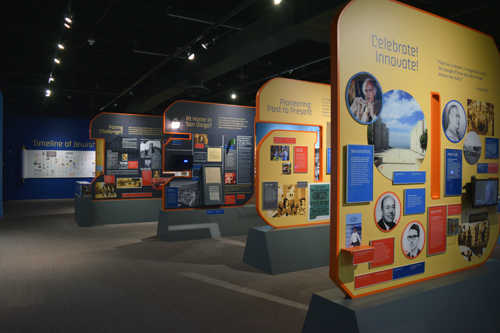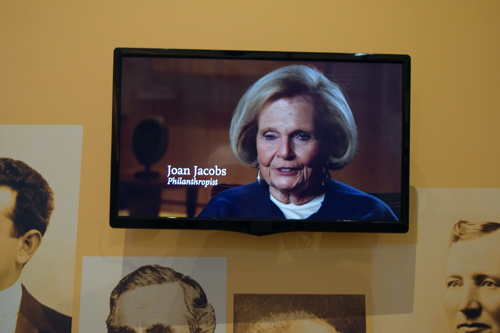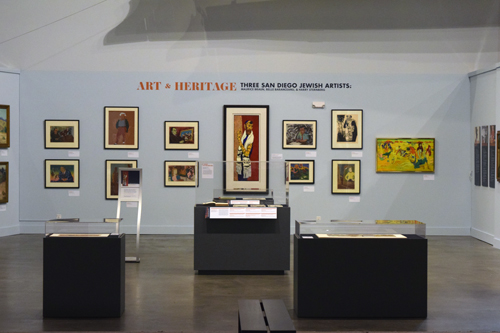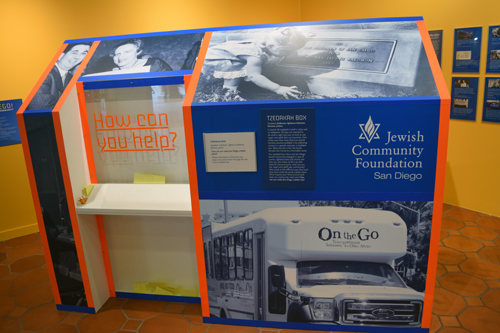By Donald H. Harrison

SAN DIEGO – Can you imagine shrinking to a tiny size and being able to walk through the pages of an interactive book? You stop on one page and you see photographs of Jewish pioneers, quotations from newspaper accounts about them, and perhaps a caption summarizing the high points of their lives.
Then, as you go further into the book, you enter the age of videotape, wherein you not only see pictures of prominent people but can hear them talking to you, about their lives, their philanthropic passions, and about how they came to San Diego in the first place.
Impossible, you say? No such book? Perhaps not. But a walk through the San Diego History Center’s exhibition, ““Celebrate San Diego! The History & Heritage of San Diego’s Jewish Community” might give you that feeling. The exhibit panels are in the form of freestanding 10 x 10 letters spelling out the name S-A-N D-I-E-G-O, and each letter of our city is themed to different eras in the Jewish experience in San Diego. The first letter begins with 1850 and the arrival of pioneer Louis Rose.
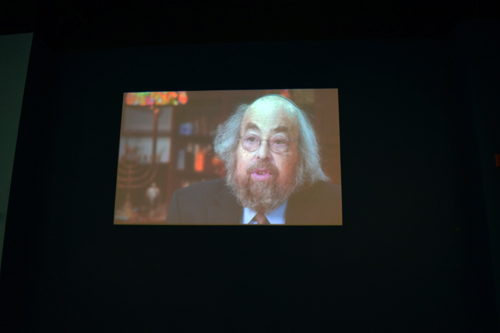
The talking book includes snippets of interviews from such modern day Jewish leaders as Rabbis Wayne Dosick and Scott Meltzer, journalist Robert Pincus; Qualcomm co-founders Irwin Jacobs and Andrew Viterbi; philanthropist Joan Jacobs (Irwin’s wife); Robert Price, talking about his father, Sol Price, who pioneered big box discount marketing with Fedmart and the Price Clubs; Waxie CEO Charles Wax, talking about his father Morris, who was a driving force for the USO; Elaine Galinson, discussing her late husband Murray and philanthropy, including fundraising for UCSD; Peter Salk, remembering his father, polio vaccine discoverer Jonas Salk; former Congresswoman Lynn Schenk and current Congresswoman Susan Davis, and many others.
What makes the exhibit curated by Joellyn Zollman even better than a book are the objects from San Diego’s Jewish history that no book could contain. Some examples are:
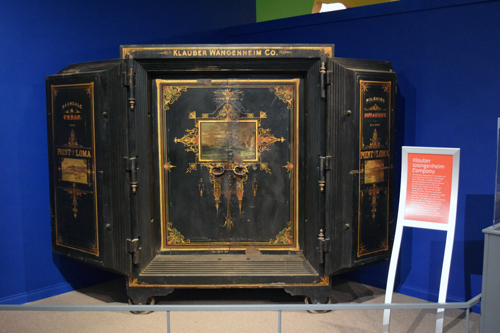
— A safe that must have weighed tons from the Klauber-Wangenheim company, distributor of wholesale groceries.
–Cans from that same company’s Point Loma brand of fruits and vegetables.
— A tiny diary written during the 1850s by teenager Victoria Jacobs.
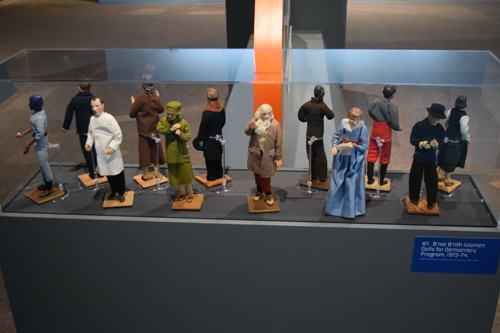
— Dolls for Democracy created by B’nai B’rith Women to teach the value of diversity and democracy and to counter anti-Semitism.
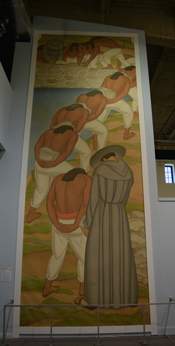
In a companion exhibit curated by Tara Centybear looking at the works of three Jewish artists who called San Diego their home – there is a wall to ceiling image by Belle Barancenau of Kumeyaay Indians bending their backs laboring to build the Padre Dam located in Mission Trails Regional Park—a clear expression of traditional Jewish concern for the underdog. Maurice Braun’s landscapes of mountain and desert; Point Loma; and the San Diego backcountry evokes the early 20th century when San Diego was “unspoiled” by its later growth. And Harry Sternberg, whose paintings and drawings often were cutting edge in their concern for civil rights, nostalgically recalls his Orthodox parentage with a piece depicting his father in tallit and tefillin.
Like any good book, the main exhibit is a volume to which one might wish to return again and again. It is filled with little morsels of information that may surprise many recently arrived or born Jewish San Diegans. For example, were you aware that one factor in the migration of Conservative Jews from North Park to the College area was a ruling in the 1950s by the Conservative movement that Jews might properly drive to shul on Shabbat?
Or were you aware that it was Vernon’s Deli in North Park that introduced the bagel to San Diego?
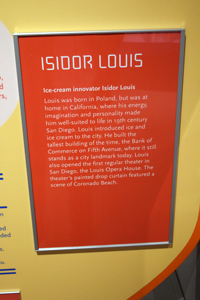 Or that Isidor Louis, the Jewish man who built the Bank of Commerce on Fifth Avenue as well as the Louis Opera House, was also the man who popularized ice cream in San Diego? According to a legend in the exhibit, he used local fruits for flavoring, which might have meant dates, figs, grapes, apricots, pears, lemons, oranges and plums. A harbinger of 31 flavors.
Or that Isidor Louis, the Jewish man who built the Bank of Commerce on Fifth Avenue as well as the Louis Opera House, was also the man who popularized ice cream in San Diego? According to a legend in the exhibit, he used local fruits for flavoring, which might have meant dates, figs, grapes, apricots, pears, lemons, oranges and plums. A harbinger of 31 flavors.
Mina Blochman, one learns, helped to establish the first Red Cross chapter in San Diego circa 1919.
And Julius Wangenheim was a founder not only of the San Diego Public Library, where a room is dedicated to his collection of rare books. But Wangenheim also helped to found the San Diego Historical Society (now the San Diego History Center) and the Marine Biological Association, known today as the Scripps Institution of Oceanography.
The exhibit in the Casa de Balboa – a building which also houses the Museum of Photographic Arts and the Model Railroad Museum – is free to the public, and will continue through the end of 2017. There is a large tzedakah box in the lobby of the museum calling upon us all to freely make donations.
*
Harrison is editor of San Diego Jewish World. He may be contacted via Donald.harrison@sdjewishworldcom
